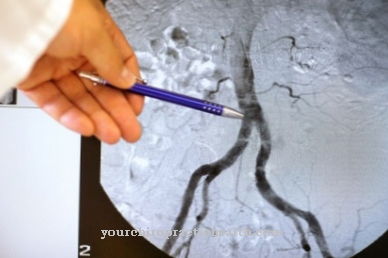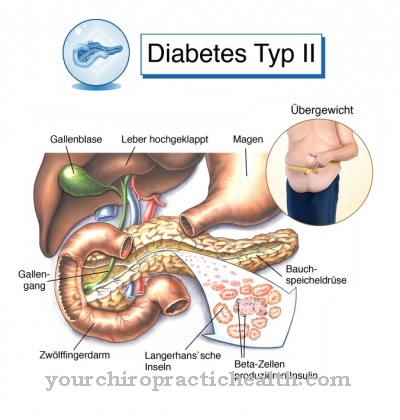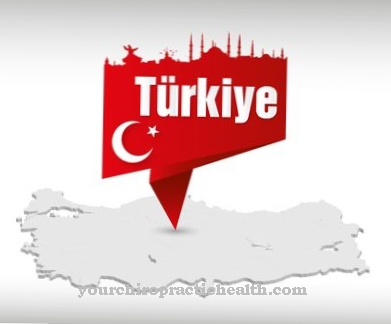The so-called Mediastinal emphysema describes the accumulation of air in the mediastinum. The disease usually occurs in connection with mechanical ventilation.The main cause is alveolar overpressure, which can occur, for example, as a result of a Valsalva maneuver, a coughing disease or a blunt chest trauma.
What is mediastinal emphysema?

© nerthuz - stock.adobe.com
The mediastinum describes a space that is located between the two lungs. Here are several vital organs such as the heart and the respiratory tract. This surrounds a supporting tissue, the so-called connective tissue. This ensures that the corresponding organs find a stable hold in the mediastinum.
The Mediastinal emphysema arises due to the passage of air into the mediastinal area. This mostly escapes from the so-called alveolar space. The function of the lungs is rarely affected. In most cases, the disease occurs in conjunction with pneumothorax or skin emphysema. Own symptoms appear rather rarely.
The attending physician can perceive a crackling sound by palpating the jugulum. If there is pronounced mediastinal emphysema, those affected often suffer from severe pericardial complaints. In addition, with pronounced mediastinal emphysema, so-called influence congestion occurs.
causes
In principle, air escapes from all perforations in organs filled with air. Usually the bronchial area or the gastrointestinal tract are affected, from which air can penetrate the mediastiunum. The doctor differentiates between spontaneous and non-spontaneous mediastinal emphysema.
So-called spontaneous mediastinal emphysema occurs without prior trauma. Lung diseases are usually not the cause. Spontaneous mediastinal emphysema often follows an intrathoracic increase in pressure. It is believed that a rupture of the alveoli causes air to pass from the airways into the mediastinum.
In most cases, pressure-increasing factors such as severe coughing, vomiting, stress or an asthma illness can be identified. It is also likely that the body's inflammatory responses in what is known as bronchial asthma cause the peripheral alveoli to rupture.
Other possible causes are spontaneous pneumomediastinum, airway constriction, the Valsalva maneuver, drug abuse or invasive ventilation.
There are many causes of non-spontaneous pneumothorax. The leakage of air as a result of trauma to a hollow organ or a tumor disease is life-threatening. The cause of mediastinal emphysema can also be foreign bodies that have penetrated the lungs.
Symptoms, ailments & signs
The organs located in the chest are displaced by the air. The individual complaints are mainly based on which organs were affected by this process. Most patients suffer from severe pain in the heart or sternum. If the windpipe is narrowed, breathing problems occur.
If the esophagus is affected, patients complain of difficulty swallowing. If blood vessels or the heart are involved, the symptoms cannot always be clearly assigned. In this case, heart palpitations and shortness of breath often occur, which also suggest other diseases. It is also possible that the leaked air penetrates into the skin. This so-called skin emphysema is characterized by the visible accumulation of air in the neck area and on the arms.
Diagnosis & course of disease
The air that collects in the mediastinal space can often be perceived by the doctor as a crackling noise. The cause of this are the air bubbles that are located under the skin. A widened mediastinal space can be seen in the chest X-ray. An inconspicuous mediastinum is usually a narrow white area between the two lungs that appear dark in the image.
Air that has entered the mediastinal space makes this area appear wider. This air-filled area and the lungs can be seen as a dark section on the X-ray. All organs that contain fluid have a light area on X-rays. This can also be seen in the blood-filled heart, which forms the white area in the mediastinum.
Complications
The mediastinal emphysema can cause various complaints. As a rule, the symptoms depend heavily on which organs are displaced in which direction and possibly deformed and damaged in the process. For this reason, a general course of the disease cannot be predicted. In most cases, however, there is discomfort and pain in the heart.
It is not uncommon for those affected to suffer from feelings of fear or panic attacks. Pain occurs, which can also spread to other regions of the body. It is not uncommon for mediastinal emphysema to be associated with breathing difficulties. Furthermore, swallowing difficulties occur, so that it is usually no longer possible to take food and fluids without further ado.
The shortness of breath can also cause people to lose consciousness and possibly injure themselves if they fall. Failure to treat mediastinal emphysema can also result in patient death. In most cases, mediastinal emphysema does not require direct treatment. Surgical intervention is only carried out in acute emergencies, but this is not associated with complications. If treatment is successful, the patient's life expectancy will not be reduced by mediastinal emphysema.
When should you go to the doctor?
People who are mechanically ventilated increasingly belong to the risk group of mediastinal emphysema. Therefore, especially those affected who are in the appropriate state of health, should inform the attending physician in the event of changes or abnormalities. Restrictions in breathing, unusual breath noises or severe chest pain are signs of possible disturbances and existing problems. A doctor should be informed immediately so that treatment can be optimized. Difficulty swallowing, racing heart, sweating and fears are signs of existing irregularities. If there is an increase in existing symptoms or if symptoms continue to spread, a doctor should be consulted as soon as possible.
If there is a visible accumulation of air in the patient's arms and neck, a doctor is required. If a lack of oxygen in the organism is noticed, the skin becomes pale or it turns blue, a doctor should be consulted. A decrease in exercise capacity, exhaustion, rapid fatigue and sleep disorders are indications that must be investigated and treated. A doctor should also be consulted if the physical and mental stressful conditions arise. Medical support can be helpful in the case of depressive behavior, aggressive tendencies, or severe mood swings. Withdrawal from social life, tearfulness or apathy indicate psychological problems that should be addressed and clarified.
Treatment & Therapy
Treatment of mediastinal emphysema is usually only symptomatic. In most cases, the air disappears on its own without treatment because it is absorbed by the surrounding tissue. In technical jargon, this process is called resorption. The pressure in the mediastinal area is rarely so high that the air has to be removed.
If this is necessary, an invasive procedure is required in which an incision is made in the patient's neck. In this way the air can escape. If the mediastinal emphysema develops into a life-threatening condition, this operation is performed. Basically, only the basic diseases are treated. These include, for example, closing a rupture or using ventilators.
If the patient is free of symptoms and symptoms, no further therapy is required. If the pain is severe, an incision cranial to the breastbone is indicated, in which a cannula is inserted into the mediastinum. In this way the air can then escape.
Outlook & forecast
The prognosis of mediastinal emphysema depends on the classification of the disease. A distinction is made between spontaneous and non-spontaneous mediastinal emphysema. The prognosis for spontaneous emphysema is favorable. Nevertheless, medical treatment should take place so that there are no complications. Symptomatic treatment takes place until freedom from symptoms can be documented. Spontaneous healing can be observed in a large number of patients. The air finds its way out of the organism independently and without further measures.
Surgical intervention is only necessary in severe cases. This is associated with risks and can lead to secondary disorders. Nevertheless, it is mostly a routine process that is usually carried out without any problems.
In the case of non-spontaneous mediastinal emphysema, the prognosis is usually poor due to the overall situation. There are pre-existing conditions that lead to severe health impairments. The patient's condition is classified as life threatening. In the event of an unfavorable course, the affected person will die prematurely.
If the acute condition is successfully overcome, further therapy is required. Check-ups must take place and a regression of the symptoms must be prevented. In addition, the causal disease must be treated until the symptoms are free. If the symptoms recur, the prognosis deteriorates further.
prevention
The human lungs are a complicated organ that fulfills a vital function - the absorption of oxygen from the air. For this reason, it is imperative not to impair their function. The lungs can be damaged by a wide variety of influences.
In mediastinal emphysema, for example, an often irreversible expansion of the smallest areas of the lung occurs. Basically, it is important to eliminate or prevent the causes of mediastinal emphysema, if possible. There is no other way to prevent mediastinal emphysema.
Aftercare
Follow-up examinations for those with mediastinal emphysema are dependent on the severity of the symptoms. In order to reduce the symptoms in the long term, individual follow-up care is arranged. To do this, it must be clarified whether there are previous illnesses that have caused the condition - if these are treated accordingly and the patient shows recovery, the follow-up care is sometimes completed in the case.
In general, sport is an effective remedy for breathing problems, as the body is more resilient and the lung volume is trained. A so-called DMP (Disease Management Program), which should be carried out once a quarter in a doctor's office, provides information about the condition of the lungs and bronchi.
Medicinal treatment is sometimes necessary until the pressure in the mediastinal area subsides and has fallen to the desired values. So far, patients should take it easy and visit their doctor regularly in order to monitor the healing process more specifically. Exercise in the fresh air for at least one hour a day is recommended.
You can do that yourself
Mediastinal emphysema usually does not require treatment by the doctor or patient. Normally, the air is absorbed by the surrounding tissue and any symptoms and complaints disappear as a result.
If high pressure builds up in the mediastinal area, therapy is indicated. Usually a minimally invasive procedure has to be carried out. The best way to support an operation is to adhere to the doctor's specifications regarding dietary measures and physical activity. If complications arise, the most important measure is to see a doctor immediately. Self-treatment should be avoided in the case of shortness of breath or pain in the mediastinal area.
In the case of severe pain, drug therapy can often be supported by home remedies such as cooling and warming. From naturopathy, devil's claw and other pain-relieving preparations are ideal. In any case, the patient should have the wound and the course of the mediastinal emphysema checked again by the responsible doctor. In addition, the cause of the disease must be determined. In this way, the development of another mediastinal emphysema can be reliably avoided.

























.jpg)


